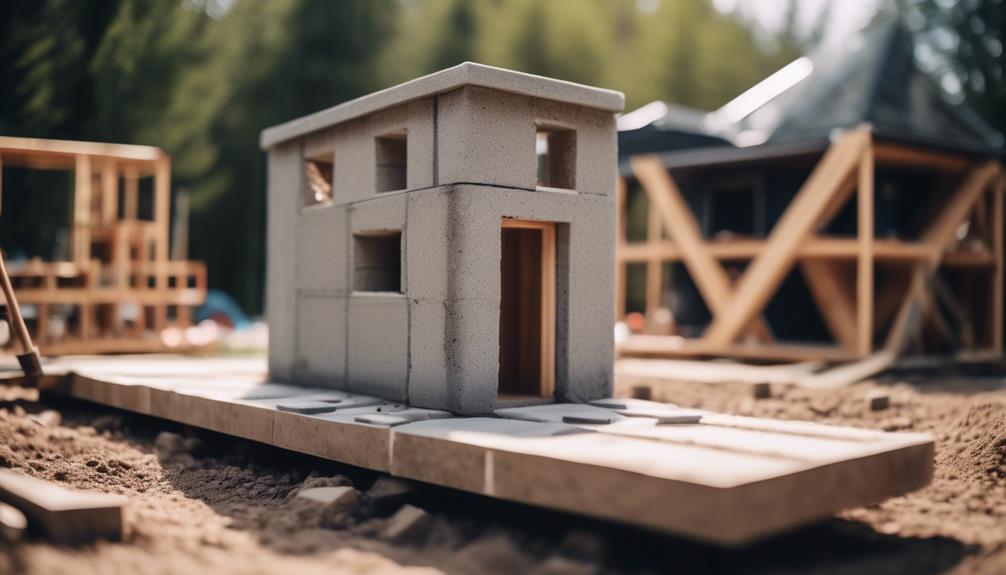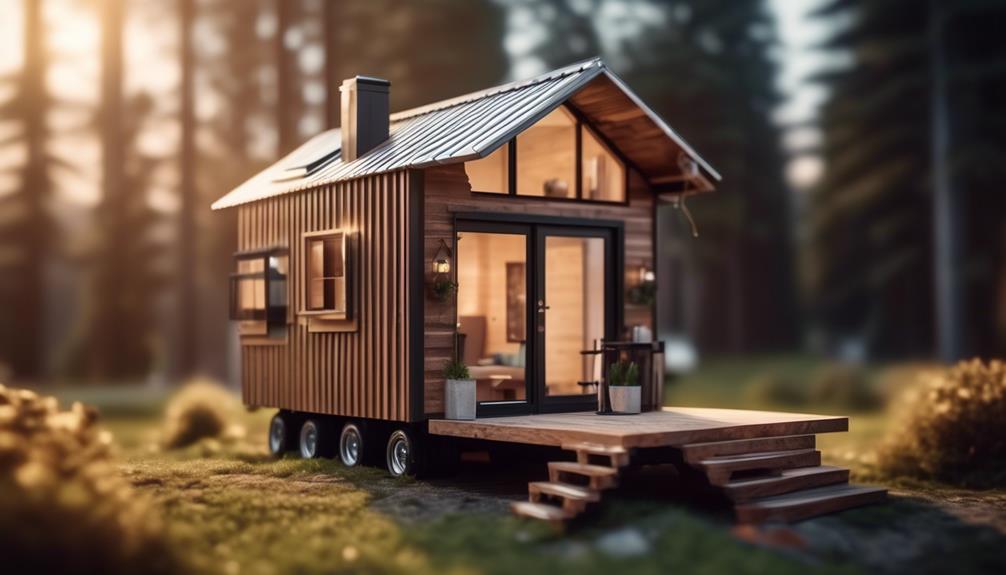As I sit here in my cozy, yet compact, tiny house, I can't help but marvel at the importance of a sturdy foundation. It's the backbone of any home, big or small, and finding the right one for your tiny house can be a game-changer.
But fear not, dear reader, for I am here to guide you through the maze of options, revealing the best foundations that will ensure your tiny house stands strong and secure. From slab foundations to skids and piers, we will explore the pros and cons, costs, and considerations of each, leaving you with the knowledge you need to make an informed decision.
So, let's embark on this exciting journey together and discover the perfect foundation for your tiny house.
Key Takeaways
- There are multiple types of foundations for tiny houses, including slab, vented crawlspace, sealed crawlspace, basement, skids or runners, and piers or tubes.
- Each type of foundation has its pros and cons, such as affordability, access to wires/plumbing, storage options, and mobility.
- Building a tiny house on a foundation can be more affordable in the long run compared to a tiny house on wheels, but there are additional costs for permits, water line and sewer connections, and complying with building codes and regulations.
- Off-grid options like compost toilets and solar panels can help reduce ongoing bills and make a tiny house on a foundation more affordable.
Types of Tiny House Foundations
When it comes to building a tiny house, choosing the right foundation is crucial for ensuring stability, longevity, and functionality. There are several types of foundations to consider, each with its own pros and cons.
One option is the slab foundation, which is sturdy, relatively affordable, and simple to build. However, it requires preplanning of drains and lacks flexibility for future modifications.
Another option is the vented crawlspace foundation, which also provides a sturdy base and access to wires and plumbing. However, it can be more expensive than a slab and may be prone to moisture issues and mold.
Sealed crawlspaces offer extra storage and better control of bugs and moisture, but they're more expensive and require HVAC.
Basement foundations provide additional storage and access to utilities, but they're the most expensive and require permits.
Skids or runners are a low-cost option that allows mobility, but they can be difficult to pass code and prone to rotting.
Each type of foundation has its benefits and drawbacks, so it's important to carefully consider your needs and budget before making a decision.
Choosing a foundation over a trailer for a tiny house offers the advantage of a more stable and permanent structure.
Pros and Cons of Tiny House Foundations
Considering the various types of tiny house foundations, it's important to weigh the pros and cons of each option to make an informed decision for your specific needs. To help you in this process, I have created a table that outlines the advantages and disadvantages of different types of tiny house foundations:
| Foundation Type | Advantages | Disadvantages |
|---|---|---|
| Slab Foundation | – Sturdy foundation | – Have to preplan drains |
| – Relatively affordable | – Lacks flexibility in the future | |
| – Simple to build | – No access to run wires/lines | |
| Vented Crawlspace Foundation | – Sturdy foundation | – More expensive than slabs |
| – Still pretty inexpensive | – Moisture can lead to mold | |
| – Access to wires/plumbing | – Requires steps up into your house | |
| Sealed Crawlspaces | – Extra storage | – More expensive |
| – Access to wires/plumbing | – Newer approach | |
| – Controls bugs and moisture | – Requires HVAC | |
| Basement Foundation | – Extra storage | – Most expensive |
| – Access to wires/plumbing | – Requires permits | |
| – Low-cost square footage | – Requires engineering | |
| Skids or Runners | – Mobile in a pinch | – Hard to pass code |
| – Low-cost option | – Can rot away | |
| – Simple materials | – Hard to access under the house | |
| Piers or Tubes | – Affordable | – Requires permits |
| – Access to wires/plumbing | – Not always allowed | |
| – Easy for a DIYer | – Not an enclosed foundation |
Cost of Building a Tiny House on a Foundation

To understand the financial implications of building a tiny house on a foundation, it's essential to consider the overall cost involved in the construction process. When comparing the cost of building a tiny house on a foundation versus a traditional home, there are several factors to consider.
The cost of the foundation itself, such as a simple slab foundation, can range from $1,000 to $2,000. Additionally, there are expenses for building permits, water line and sewer connections, and complying with zoning ordinance regulations.
However, one must also consider the long-term sustainability of a tiny house on a foundation. Off-grid options like compost toilets and solar panels can be more affordable in the long run, eliminating ongoing bills.
It's crucial to weigh the cost comparison and long-term sustainability when deciding to build a tiny house on a foundation.
Considerations for Building a Tiny House on a Foundation
One important consideration when building a tiny house on a foundation is the primary connection between the house walls and the foundation, which involves using a pressure-treated sill plate.
The foundation materials and design play a crucial role in the structural integrity and longevity of the tiny house. It's essential to choose a foundation material that's durable, such as concrete or treated wood, to ensure stability and support.
Additionally, the foundation design should comply with local building codes and regulations to ensure the safety and legality of the structure. Proper sealing and insulation techniques should be employed to prevent air leakage and insect intrusion.
Affordability of Building a Tiny House on a Foundation

When it comes to the affordability of building a tiny house on a foundation, there are several factors to consider that can make it a more cost-effective option compared to other housing alternatives. Here are some cost-saving tips and off-grid options to make building a tiny house on a foundation more affordable:
- Opting for a tiny house foundation instead of a trailer can save money in the long run.
- Expenses for building permits, water line, and sewer connection should be factored into the budget.
- Off-grid options like compost toilets and solar panels can eliminate ongoing bills and reduce costs over time.
Building Codes and Regulations for Tiny House Foundations
Building codes and regulations for tiny house foundations play a crucial role in ensuring the safety, structural integrity, and compliance of these unique dwellings with local building standards. These codes and regulations outline the specific requirements and restrictions that must be followed when constructing a tiny house foundation.
They cover various aspects such as the type of foundation allowed, minimum size requirements, load-bearing capacity, and setback regulations. The permitting process is an important part of these regulations, as it involves obtaining the necessary approvals and inspections from local authorities before starting construction.
Building code restrictions are put in place to ensure that the foundation meets the necessary safety standards and is built to withstand environmental conditions. Adhering to these regulations is essential to avoid any legal issues and ensure that the tiny house foundation is built to code.
Frequently Asked Questions
What Are the Advantages of Choosing a Tiny House on a Foundation Over a Tiny House on Wheels?
Choosing a tiny house on a foundation offers advantages like extra storage, access to wires and plumbing, and low-cost square footage. Compared to tiny houses on wheels, building on a foundation can be more affordable in the long run.
Are There Any Specific Building Codes or Regulations That Apply to Tiny House Foundations?
Building codes for tiny house foundations can vary depending on location. Zoning regulations may present challenges, but with proper planning and compliance, it's possible to navigate them and build a legally compliant and innovative tiny house on a foundation.
What Factors Should Be Considered When Deciding on the Type of Foundation for a Tiny House?
Factors to consider when deciding on a tiny house foundation include cost, access to wires/plumbing, flexibility, and moisture control. Important considerations include permits, building codes, and compliance with local regulations.
Can a Tiny House on a Foundation Be Easily Modified or Expanded in the Future?
Yes, a tiny house on a foundation can be easily modified and expanded in the future. With the right foundation choice, such as a vented crawlspace or basement, you have more flexibility for future modifications and expansion possibilities.
What Are Some Off-Grid Options That Can Be Incorporated Into a Tiny House on a Foundation to Reduce Ongoing Bills?
Off-grid options for a tiny house on a foundation can include solar panels, compost toilets, and rainwater harvesting systems. These cost-saving measures can help reduce ongoing bills and make the house more sustainable.
Conclusion
After exploring the various types of foundations for tiny houses, weighing their pros and cons, considering costs and regulations, it's clear that finding the best foundation is crucial to ensuring a solid and sustainable home.
From slab foundations to skids or piers, each option offers its own unique benefits and drawbacks.
So, when it comes to choosing the perfect foundation for your tiny house, remember that 'a strong foundation sets the stage for a lifetime of stability and peace of mind.'

